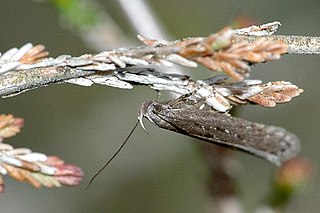
Neofaculta ericetella is a moth of the family Gelechiidae. It is found in Europe and Asia Minor.
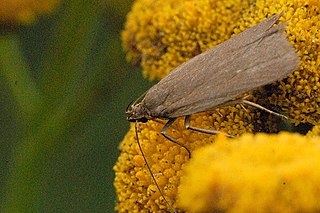
Scrobipalpa acuminatella is a moth of the family Gelechiidae. It is found in most of Europe, as well as Turkey, southern Siberia, Central Asia and China (Anhui). It was recently reported from Canada, with records from Ontario and Québec.
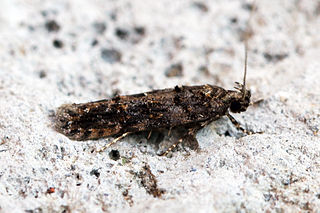
Teleiopsis diffinis is a moth of the family Gelechiidae. It is found in Europe, North Africa, the Near East, central Asia and Siberia (Transbaikalia).
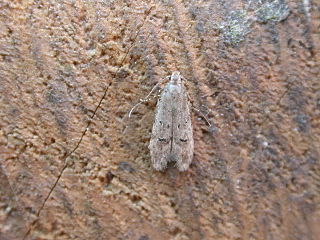
Teleiodes vulgella is a moth of the family Gelechiidae. It is known from most of Europe, east to the southern Ural and the Volga region.
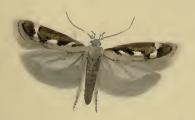
Caryocolum marmorea is a moth of the family Gelechiidae. It is found from Scandinavia to the Mediterranean islands, and from Ireland to Poland, Hungary and Greece. It is also found on the Canary Islands and Madeira. It is also found in North America.

Scrobipalpa costella is a moth of the family Gelechiidae. It is found in western Europe.
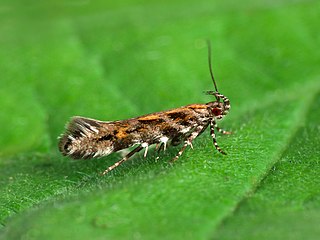
Aristotelia ericinella is a moth of the family Gelechiidae. It is found in most of Europe, except most of the Balkan Peninsula.

Bryotropha domestica is a moth of the family Gelechiidae. It is found from Ireland to Germany, Slovakia, Romania and Bulgaria and from the Benelux to the Iberian Peninsula, Sicily, Crete and Cyprus. It is also found in Morocco, Algeria, Tunisia, Libya, the Middle East, Turkmenistan, Saudi Arabia and Yemen.

Scrobipalpa artemisiella is a moth of the family Gelechiidae. It is found in most of Europe, Turkey and Syria through the Caucasus and Central Asia to Irkutsk and Mongolia. It has also been recorded from North America, but this records requires confirmation.

Bryotropha desertella is a moth of the family Gelechiidae. It is found in most of Europe, North Africa (Morocco), Turkey, Turkmenistan and the Russian Far East.
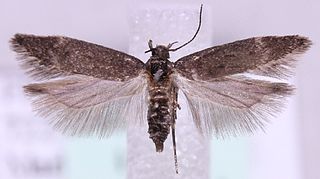
Bryotropha similis is a moth of the family Gelechiidae. It has a Holarctic distribution, including Greenland and Iceland. It is widespread in northern, central and eastern Europe. In southern Europe, it is only known from a few mountainous regions. It is also found throughout the Palaearctic.

Metzneria metzneriella is a moth of the family Gelechiidae. It is widely distributed throughout Europe, as well as Turkey and southern Siberia. The habitat consists of dry pastures and calcareous soils.

Gelechia rhombella, the apple groundling, is a moth of the family Gelechiidae. It is found in Europe, the Caucasus, Transcaucasia, southern Siberia, the Russian Far East, Korea and China.

Scrobipalpa atriplicella, the goosefoot groundling moth, is a moth of the family Gelechiidae. It is found from most of Europe throughout Asia to Kamchatka and Japan. It is an introduced species in North America.
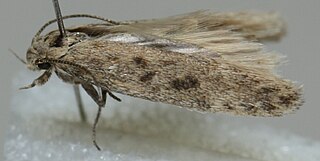
Scrobipalpa obsoletella, the summer groundling, is a moth of the family Gelechiidae. It is found in most of Europe, Turkey, the Caucasus, from Iran to Asian Russia (Transbaikal) and Mongolia. It has also been recorded from New Zealand, South Africa and North America, where it is probably an introduced species. The habitat consists of coastal salt marshes and sandy beaches.

Scrobipalpa samadensis, the buck's-horn groundling, is a moth of the family Gelechiidae. It is found in most of Europe and Russia.
Scrobipalpa blapsigona is a moth in the family Gelechiidae. It was described by Edward Meyrick in 1916. It is found in southern India and Bengal.
Scrobipalpa chersophila is a moth in the family Gelechiidae. It was described by Edward Meyrick in 1909. It is found in South Africa.
Scrobipalpa incola is a moth in the family Gelechiidae. It was described by Edward Meyrick in 1912. It is found in South Africa and Zimbabwe.
Scrobipalpa pendens is a moth in the family Gelechiidae. It was described by Edward Meyrick in 1918. It is found in South Africa.














